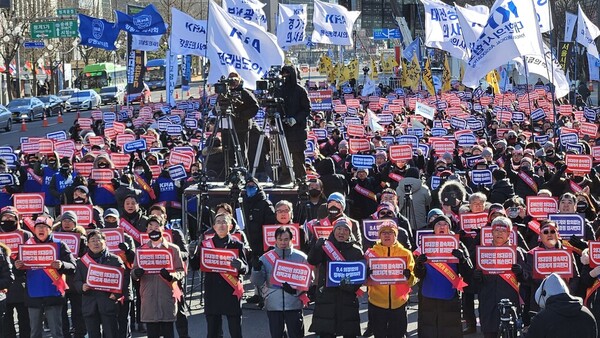As the government prepares to announce an increase in medical school enrollment quotas before the Lunar New Year holidays, the medical community is on edge.
Following an emergency meeting by the Korean Intern and Resident Association (KIRA) last Friday, the Korean Medical Association (KMA) held a board meeting on Monday, with a news conference scheduled for early Tuesday to reveal its stance on the proposed expansion.

The KMA surveyed its members, finding that 86 percent of junior doctors from 55 training hospitals are willing to participate in a strike if the quotas are increased.
The association argues that such an expansion won't address healthcare needs and will worsen existing distortions, a sentiment echoed by a majority of doctors.
In a recent survey by KMA’s Medical Policy Research Center, 81.7 percent of respondents opposed the expansion, citing reasons such as a perceived sufficiency of doctors (49.9 percent), anticipated decreases in demand due to a declining population (16.3 percent), and concerns about increased medical costs (15.0 percent) and declining medical care quality (14.4 percent).
The survey, conducted from Nov. 10 to 17 last year, included 4,010 respondents. Of the 733 respondents (18.3 percent) in favor of expanding the number of medical students, 49 percent highlighted the need to fill gaps in essential medical fields, while 24.4 percent aimed to address regional disparities. Additionally, 7.9 percent supported the increase due to concerns that patients cannot receive medical care due to a shortage of doctors.
A proposal to convert oriental medicine school students into medical school admissions faced opposition from 76.5 percent of respondents (2,508). Regarding giving preference to regional applicants, pros (51.5 percent) slightly outnumbered cons (48.5 percent). However, the proposal to introduce the regional doctor system saw cons (62.2 percent) overwhelming pros (35.6 percent).
Doctors said they avoid essential care because of low medical fees (45.4 percent, 1,826), lack of legal protection against malpractice (36.0 percent, 1,445), and excessive workload (7.9 percent, 317).
Besides, to solve the problem of "emergency room pilgrimage," they replied that it is necessary to limit the use of emergency rooms by mild patients (36.2 percent), strengthen the emergency triage and transportation system (27.5 percent), and establish a medical delivery system (22.6 percent).
The respondents also said the "open-and-dash phenomenon at pediatrics” could be solved by supporting the operation of pediatrics (47.2 percent), campaigns to improve consumer healthcare use behavior (14.0 percent), expanding early morning, night, and holiday clinics (8.1 percent), developing and distributing real-time appointment management systems, and supporting the employment of part-time doctors during certain hours.
"The government claims that there will be a shortage of 15,000 doctors by 2035, but this figure is unreliable because it reflects only some biased studies that exclude various indicators that determine the shortage, such as medical access, waiting time for surgery and hospitalization, and health indicators," said Woo Bong-sik, head of the research center. “A more cautious approach is necessary.”
Statements were also issued criticizing the "essential healthcare policy package," which included expanding medical students.
The Seoul Medical Association (SMA), for instance, criticized it in its statement Friday as a "misrepresentation of ideas" and "nothing more than a good-looking package of the existing position to solve the regional healthcare vacuum by relying on the so-called trickle-down effect."
"We are worried that this would be the last straw that will break the back of the Korean healthcare system, which has been barely sustaining itself by proceeding unilaterally while ignoring the voices of medical professionals in the field," the SMA said. "If we fail to accurately diagnose the problems of the healthcare system, which appears good outside but is festering inside and groaning with symptoms here and there, and come up with improvement measures, the entire damage will be passed on to the people."
Related articles
- Korea's health minister stresses need to increase medical students at OECD meet
- ‘86% of junior doctors will strike if medical student number increases’
- Doctors express ‘regret’ at reports on sharp increase in physicians
- [Top 10 Healthcare News in 2023 ①] Korea to expand medical school quotas starting from 2025
- Government dispels election rumors surrounding medical school enrollment increase
- Trainee doctors at ‘Big 5’ hospitals to resign en masse on Monday
- Resigned trainee pediatricians demand urgent policy to revive essential healthcare

